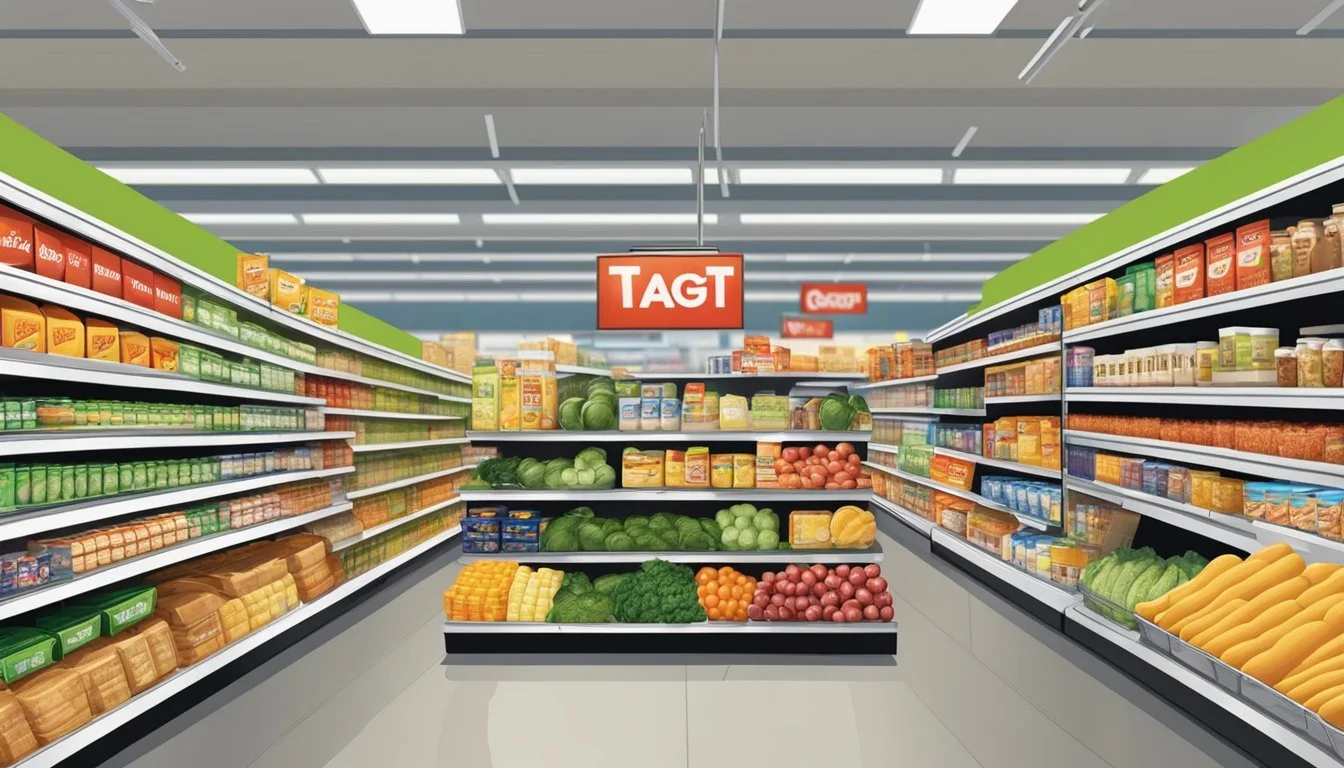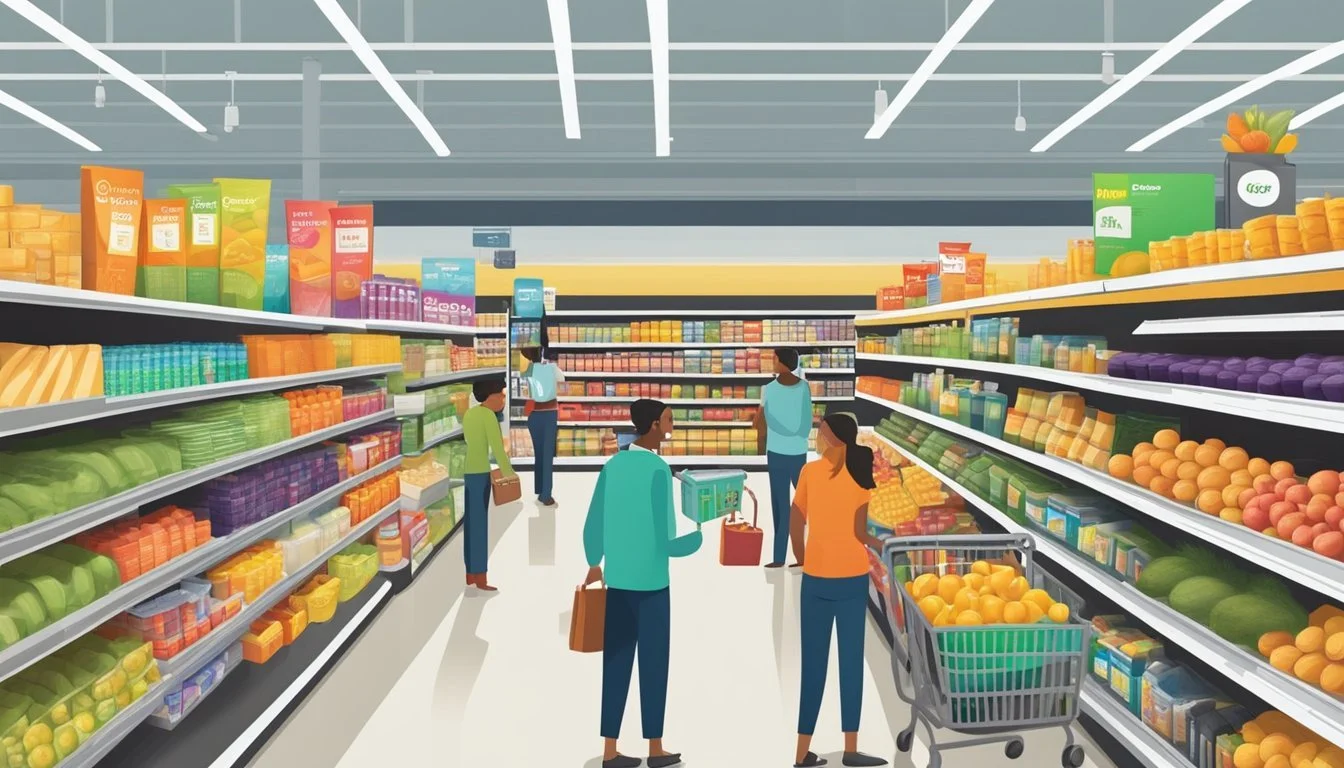Target vs Dollar General
Comparing Prices, Quality, and Selection
Target and Dollar General are two popular retailers offering groceries and household essentials at competitive prices. While both stores aim to provide value to shoppers, they have distinct business models and target different customer segments.
Target tends to offer a wider selection of groceries and higher-quality products compared to Dollar General, but often at slightly higher prices. Target's stores are typically larger, with a more upscale atmosphere and additional departments like clothing and electronics. Dollar General, on the other hand, focuses on smaller stores in rural and urban areas, emphasizing everyday low prices on a more limited selection of items.
Shoppers looking for the absolute lowest prices on basic groceries and household goods may find better deals at Dollar General. However, those seeking a broader range of options, including fresh produce and name-brand items, might prefer Target's grocery offerings. The choice between these two retailers often comes down to individual priorities - price, selection, store experience, and location.
History and Company Background
Target and Dollar General have distinct origins and growth trajectories that shaped their current positions in the retail landscape. Both companies adapted to changing consumer needs over decades, expanding their store networks and product offerings.
The Evolution of Target
Target's roots trace back to 1902 when George Dayton founded Goodfellow Dry Goods in Minneapolis. The company rebranded as Dayton's Dry Goods Company in 1938 and later became Dayton Corporation.
In 1956, Dayton Corporation opened its first Target store in Roseville, Minnesota. The company aimed to create a discount store with higher-end merchandise, differentiating itself from competitors.
Target expanded rapidly in the 1960s and 1970s, becoming a publicly-held company in 1967. It continued to grow through acquisitions and new store openings, eventually spinning off from Dayton Corporation in 2000.
Dollar General's Growth Story
Dollar General was founded in 1939 by J.L. Turner and his son Cal Turner Sr. in Scottsville, Kentucky. The company initially operated as a wholesaler, but transitioned to retail in 1955 with the opening of the first Dollar General store.
The company's focus on providing affordable goods in small-town markets drove its early success. Dollar General went public in 1968 and expanded steadily throughout the following decades.
In the 1990s and 2000s, Dollar General accelerated its growth, opening thousands of new stores across the United States. The company briefly went private in 2007 before returning to public ownership in 2009.
Today, Dollar General operates over 18,000 stores in 47 states, focusing on small-format stores in rural and suburban areas.
Store Locations and Accessibility
Target and Dollar General have distinct approaches to store locations, impacting their accessibility for different customer segments. Target focuses on urban and suburban areas, while Dollar General has a strong presence in rural communities.
Target's Geographic Reach
Target operates over 1,900 stores across the United States. The retailer primarily concentrates on urban and suburban locations, targeting densely populated areas. Most Target stores are situated in shopping centers or standalone buildings near major roads and highways.
Target's strategy emphasizes larger format stores, typically ranging from 135,000 to 175,000 square feet. These spacious locations offer a wide variety of products, including groceries, clothing, and home goods.
While Target's locations are convenient for many shoppers, they may be less accessible for those in rural areas. The company has been expanding its small-format stores in recent years to reach more urban neighborhoods and college campuses.
Dollar General in Rural America
Dollar General has over 18,000 stores across 47 states, with a strong focus on rural and small-town America. The company's strategy targets communities with populations of 20,000 or less, often in areas underserved by larger retailers.
Dollar General stores are typically smaller, around 7,400 square feet, allowing for quick and convenient shopping experiences. The company aims to locate stores within a 5-minute drive of their target customers.
In many rural areas, Dollar General serves as the primary source for groceries and household essentials. The retailer's expansion into fresh produce has further increased its importance in these communities.
Dollar General's widespread rural presence makes it more accessible than Target for many Americans living outside major urban centers. However, the company has faced criticism for its impact on local businesses in small towns.
Product Range and Quality
Target and Dollar General offer distinct product selections and quality levels in their grocery departments. Both aim to provide affordable options, but their approaches differ in key areas.
Fresh Produce and Meat Selection
Target emphasizes fresh produce and meats in its grocery sections. Many Target stores feature extensive produce departments with a wide variety of fruits and vegetables. Their selection often includes organic options alongside conventional produce. Target's meat department typically offers chicken, beef, pork, and fish, with both fresh and frozen choices available.
Dollar General has been expanding its fresh food offerings. Select DG Market locations now carry produce like tomatoes, onions, and apples. However, their fresh selection remains more limited compared to Target. Dollar General's meat options tend to focus on frozen and packaged items rather than fresh cuts.
Pantry Staples and Dairy Products
Target stocks a broad range of pantry staples and dairy products. Their shelves contain multiple brands of pasta, cereal, coffee, and canned goods. The dairy section usually features various types of milk, cheese, and yogurt, including both name-brand and private-label options.
Dollar General offers a more streamlined selection of pantry and dairy items. Their focus is on providing affordable basics. Shoppers can find essential items like pasta, cereal, and canned vegetables, but with fewer brand choices. Dollar General's dairy selection typically includes milk, eggs, and cheese, prioritizing common varieties at low prices.
Pricing Strategies
Target and Dollar General employ distinct pricing strategies to attract customers and drive sales. Both retailers focus on offering competitive prices, but their approaches differ in key ways.
Target's Competitive Pricing
Target uses a dynamic pricing model to stay competitive in the retail market. The company regularly adjusts prices based on market trends, competitor pricing, and consumer demand. Target offers a price match guarantee, allowing customers to request a price adjustment if they find an identical item for less at select competitors.
Target's REDcard provides an additional 5% discount on most purchases, incentivizing customer loyalty. The retailer also runs frequent promotions and sales events, including its popular "Deal Days" to compete with Amazon's Prime Day.
Target participates in the WIC program, offering affordable options for families in need.
Dollar General's Low Price Commitment
Dollar General focuses on maintaining consistently low prices across its product range. The retailer's strategy revolves around offering items at 20% to 40% less than full-price retailers, with most products priced under $10.
Dollar General achieves these low prices through several methods:
Limited product assortment
No-frills store layouts
Minimal staffing
Efficient supply chain management
The company's "Every Day Low Prices" policy ensures customers can find affordable options on each visit. Dollar General also offers digital coupons and weekly ads featuring additional savings.
Dollar General's pricing strategy caters to budget-conscious shoppers, including those in rural areas with limited retail options.
Shopping Experience
Target and Dollar General offer distinct shopping experiences tailored to different customer needs. The store layouts, product selections, and overall atmospheres shape how shoppers interact with each retailer.
Navigating Target Stores
Target stores feature wide aisles and clearly marked sections, making navigation straightforward. Bright lighting and eye-catching displays create an inviting atmosphere. The grocery area typically occupies a significant portion of the store, with fresh produce, meat, and dairy prominently featured.
Target's inventory includes a mix of name-brand and private-label products across various price points. This diversity allows customers to choose based on their preferences and budget. Self-checkout kiosks complement staffed registers, offering convenience during busy periods.
Many Target locations have in-store Starbucks cafes, adding to the shopping experience. The retailer's mobile app provides digital coupons and a store map to help customers locate items efficiently.
The Simplicity of Shopping at Dollar General
Dollar General emphasizes a no-frills shopping experience focused on convenience and affordability. Stores are typically smaller than Target, with a straightforward layout designed for quick trips. Aisles are narrower but organized to maximize space and product visibility.
The inventory at Dollar General consists primarily of everyday essentials and basic grocery items. While the selection may be more limited, it covers most household needs. The retailer stocks a mix of national brands and its own private-label products at competitive prices.
Dollar General stores often have fewer checkout lanes than Target, but the smaller store size usually means shorter lines. Many locations are cash-focused, though card payments are accepted. The simplified approach aims to provide a fast, budget-friendly shopping option for customers.
Brand and Private Label Offerings
Target and Dollar General both offer a mix of national brands and private label products, giving shoppers budget-friendly alternatives across various categories. Each retailer has developed its own exclusive brands to differentiate its offerings and appeal to cost-conscious consumers.
Target's Exclusive Brands
Target's Good & Gather line stands out as a key private label offering in the grocery aisle. This brand covers a wide range of food and beverage products, from fresh produce to frozen meals. Good & Gather items are designed to compete with national brands on quality while providing better value.
Target has invested heavily in developing its store brands. The retailer's food and beverage business has grown significantly, reaching $24 billion in sales. This growth is partly attributed to the success of its private label products.
Target's store brands now appear in over 55% of shopper baskets, indicating strong customer acceptance and trust in these offerings.
Dollar General's Private Labels
Dollar General has expanded its private label assortment in recent years to meet increasing consumer demand for affordable options. The retailer offers several exclusive brands across various product categories, including food, household items, and personal care products.
Dollar General's private labels aim to provide quality alternatives to national brands at lower price points. This strategy helps attract budget-conscious shoppers looking to stretch their dollars further.
The expansion of private label offerings has been a key focus for Dollar General, especially as American consumers seek ways to save money on everyday essentials. These store brands help differentiate Dollar General from competitors and create customer loyalty.
Community Impact and Presence
Target and Dollar General have distinct approaches to community engagement and market presence. Their strategies significantly influence local economies, job opportunities, and food accessibility in different areas.
Target's Role in the Community
Target focuses on urban and suburban areas, often serving as anchor stores in shopping centers. The company partners with local organizations to support education, wellness, and disaster relief efforts. Target's presence typically brings higher-paying jobs and a wider range of products to communities.
Target stores accept WIC benefits, improving food access for low-income families. The retailer has also launched initiatives to address food deserts by opening smaller-format stores in underserved areas.
Dollar General's Outreach and Expansion
Dollar General aggressively expands into rural and low-income urban areas. The company opens approximately four new stores daily, targeting communities too small for Walmart or traditional grocery stores.
While Dollar General provides affordable goods in underserved areas, its rapid expansion has raised concerns. Some critics argue that Dollar General's presence can lead to the closure of local grocery stores, potentially exacerbating food deserts.
Dollar General stores often stock limited fresh produce and accept WIC benefits. The company has launched the DG Better For You program to offer healthier food options and recipes in-store.
E-commerce and Online Shopping
Target and Dollar General have embraced digital commerce to varying degrees. Both retailers aim to provide convenient online shopping experiences, though their strategies and capabilities differ significantly.
Target Online and Omnichannel Presence
Target has developed a robust omnichannel strategy. The retailer offers same-day delivery through its Shipt service, which can be accessed via Target.com or the Target mobile app. Customers can choose from a wide selection of groceries, including fresh food.
Target's digital sales have grown substantially in recent years. The company has invested heavily in its e-commerce infrastructure and fulfillment capabilities. Many Target stores now serve as mini-distribution centers for online orders.
The retailer competes directly with Amazon and Walmart in the online grocery space. Target's acquisition of Shipt in 2017 helped accelerate its same-day delivery capabilities.
Dollar General's Digital Strategy
Dollar General has been slower to embrace e-commerce compared to Target. The discount chain has focused primarily on its physical store expansion. However, Dollar General has begun to develop its digital presence in recent years.
The retailer launched its DG GO! mobile app, which allows customers to scan items as they shop in-store and check out more quickly. Dollar General has also partnered with Instacart to offer same-day delivery from select locations.
Dollar General's online offerings are more limited than Target's, particularly in fresh food. The company's e-commerce strategy targets rural customers who may have fewer online shopping options.
Sustainability and Health Initiatives
Target and Dollar General have taken different approaches to sustainability and health in their stores. These initiatives impact product offerings, packaging, and overall shopping experiences.
Target's Commitment to Sustainability
Target has set ambitious sustainability goals for its operations and products. By 2040, the company aims to design 100% of its owned brand products for a circular future. This includes using recycled or renewable materials and reducing packaging waste. Target has also invested in renewable energy, with plans to power its operations entirely through clean sources.
In-store recycling programs allow customers to return plastic bags and other materials. Target has expanded its selection of eco-friendly products, offering more organic and natural options. The company has also committed to reducing sodium content in many of its food items.
Fresh produce sections in Target stores have grown, providing shoppers with more fruits, vegetables, and healthy alternatives to processed foods. These efforts align with Target's goal of making sustainable and nutritious choices more accessible to consumers.
Healthier Choices at Dollar General
Dollar General has taken steps to improve its health-focused offerings, particularly in areas with limited access to fresh food. The company has introduced DG Markets, an expanded store format that includes a wider selection of fresh produce, dairy, and meats.
According to Coresight Research, Dollar General plans to have fresh produce in over 10,000 of its stores. This initiative aims to address food deserts and provide affordable, healthier options to underserved communities.
While not as extensive as some competitors, Dollar General has increased its selection of lower-sodium products and healthier snack alternatives. The company has also introduced more private-label items with reduced sugar and fat content.
Dollar General's focus on value still includes many processed foods, but efforts to incorporate fresher items like fruits and low-fat dairy products demonstrate a shift towards healthier options. The company continues to balance affordability with improved nutritional choices for its customers.
Conclusion
Target and Dollar General offer distinct shopping experiences for consumers. Target provides a wider selection of products, including higher-end options and exclusive brands. Its stores are typically larger and more aesthetically pleasing.
Dollar General focuses on value and convenience with smaller stores in more locations. It excels in offering everyday essentials at low prices, making it accessible for budget-conscious shoppers.
For groceries, Target usually has a more extensive fresh produce section. Dollar General's grocery offerings are more limited but emphasize shelf-stable items and basics.
Both retailers stock housewares and greeting cards. Target tends to have trendier home goods, while Dollar General provides affordable options for basic household needs.
The better choice depends on individual preferences and needs. Target is ideal for those seeking variety and quality. Dollar General serves those prioritizing affordability and quick trips.
Ultimately, many consumers may find value in shopping at both stores. Target for broader selections and Dollar General for budget-friendly essentials.










